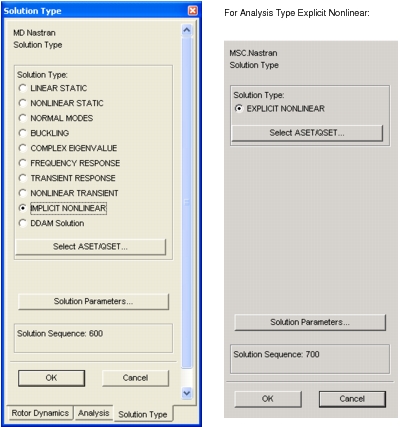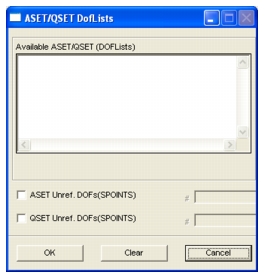

Solution Type | Defines the solution type. |
• Linear Static | Selects Solution Sequence (SOL) 101, 114, 1, or 47 depending on the selected Solution Parameters. You may select one or more subcases in SOLs 1 and 101. |
• Nonlinear Static | Selects Solution Sequence 66 or 106, depending on the version of MD Nastran. Version 66 and below yields SOL 66, and Version 67 and above yields SOL 106. You may select one or more subcases. |
• Normal Modes | Selects Solution Sequence 103, 115, 3, or 48 depending on the Solution Parameters. You may select only one subcase. |
• Buckling | Selects Solution Sequence 105, 77, or 5 depending on the selected Solution Parameters. Only one subcase may be selected that defines the static preload. The buckling subcase is automatically generated. The output requests for this Solution Type are applied to the static preload subcase. The default output requests for the buckling subcase are displacements and constraint forces. |
• Complex Eigenvalue | Selects Solution Sequence 107, 110, 28, or 29 depending on the selected Solution Parameters. You may select only one subcase. |
• Frequency Response | Selects Solution Sequence 108, 111, 118, 26, or 30 depending on the selected Solution Parameters. You may specify only one subcase for Solution Sequences 118, 26, or 30. For Solution Sequences 108 or 111, multiple subcases may be selected. |
• Transient Response | Selects Solution Sequence 109, 112, 27, or 31 depending on the selected Solution Parameters. You may specify only one subcase for Solution Sequences 27 or 31. For Solutions Sequences 109 or 112, multiple subcases may be selected. |
• Nonlinear Transient | Selects Solution Sequence 99 or 129, depending on the MD Nastran Version. Version 66 and below yields SOL 99; Version 67 and above yields SOL 129. You may select only one subcase. |
• Implicit Nonlinear | Selects Solution Sequence 400 or 600 (depending on “SOL400RUN* toggle). |
• DDAM Solution | Selects Solution Sequence 187, Dynamic Design Analysis Method (DDAM). |
• Explicit Nonlinear | Selects Solution Sequence 700. |
Select ASET/QSET... |  • Select existing Degree of Freedom Lists for use in making an ASET or a QSET in the input file. • The ASET toggle creates a user selected unreferenced SPOINTS in the ASET of input file. • The QSET toggle creates a user selected number of unreferenced SPOINTS in the QSET of the input file. |
Solution Parameters... | Brings up a solution-type-dependent subordinate form that allows you to specify parameters which apply to the complete solution. |
Solution Type | Database Run | Cyclic Symmetry | Formulation | MD Nastran Version | Solution Parameter Settings |
Linear Static | Off | Off | -- | -- | 1 |
Off | On | -- | -- | 47 | |
On | Off | -- | -- | 101 | |
On | On | -- | -- | 114 | |
Nonlinear Static | -- | -- | -- | 66 or Below | 66 |
-- | -- | -- | 67 or Above | 106 | |
Normal Modes | Off | Off | -- | -- | 3 |
Off | On | -- | -- | 48 | |
On | Off | -- | -- | 103 | |
On | On | -- | -- | 115 | |
Buckling | Off | Off | -- | -- | 5 |
On | On | -- | -- | 77 | |
On | Off | -- | -- | 105 | |
Complex Eigenvalue | Off | -- | Direct | -- | 28 |
Off | -- | Modal | -- | 29 | |
On | -- | Direct | -- | 107 | |
On | -- | Modal | -- | 110 | |
Frequency Response | Off | -- | Direct | -- | 26 |
Off | -- | Modal | -- | 30 | |
On | Off | Direct | -- | 108 | |
On | -- | Modal | -- | 111 | |
On | On | Direct | -- | 118 | |
Transient Response | Off | -- | Direct | -- | 27 |
Off | -- | Modal | -- | 31 | |
On | -- | Direct | -- | 109 | |
On | -- | Modal | -- | 112 | |
Nonlinear Transient | -- | -- | -- | 66 or Below | 99 |
-- | -- | -- | 67 or Above | 129 | |
Implicit Nonlinear | 400 600 | ||||
DDAM Solution | 2004 | 187 | |||
Explicit Nonlinear | 2005 | 700 |